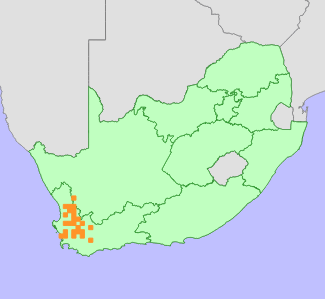|
Scientific Name | Heliophila elata Sond. |
Higher Classification | Dicotyledons |
Family | BRASSICACEAE |
National Status |
Status and Criteria | Vulnerable A2c |
Assessment Date | 2016/02/02 |
Assessor(s) | N.A. Helme & D. Raimondo |
Justification | A widespread species (EOO 27 058 km²) that is becoming rarer in many areas due to habitat loss to crop cultivation. It is estimated that there has been at least a 30% population reduction in the past 20 years (generation length 15 years). |
Distribution |
Endemism | South African endemic |
Provincial distribution | Northern Cape, Western Cape |
Range | Bokkeveld Mountains to Worcester. |
Habitat and Ecology |
Major system | Terrestrial |
Major habitats | Matjiesfontein Quartzite Fynbos, Western Coastal Shale Band Vegetation, Leipoldtville Sand Fynbos, Hopefield Sand Fynbos, Atlantis Sand Fynbos, Kouebokkeveld Shale Fynbos, Northern Inland Shale Band Vegetation, Swartruggens Quartzite Fynbos, Piketberg Sandstone Fynbos, Bokkeveld Sandstone Fynbos, Hawequas Sandstone Fynbos, North Langeberg Sandstone Fynbos, Graafwater Sandstone Fynbos, Olifants Sandstone Fynbos, Cederberg Sandstone Fynbos, Breede Shale Fynbos |
Description | Sandy flats, mountain plateaus and slopes. |
Threats |
| Threatened by ongoing habitat loss to rapidly expanding rooibos tea and potato cultivation in the Sandveld and on the Bokkeveld Escarpment, as well as fruit and vineyard cultivation in the Olifants River Valley, Koue Bokkeveld and on the Piketberg. Subpopulations on slopes in montane areas such as the Cederberg, Hex River Mountains and Langeberg Mountains are not threatened. |
Population |
More than 70% of subpopulations in deep sandy soils in the Olifants River valley, Sandveld and Bokkeveld Escarpment have been lost to crop cultivation in the past 20 years (N.A. Helme pers. comm. 2007). This species is however also fairly common in well-protected montane areas such as the Cederberg and Hex River Mountains, and it is therefore estimated that this loss represents a reduction of between 30 and 50% of the population. This is a long-lived woody perennial, and its generation length is estimated to be at least 15 years.
|
Population trend | Decreasing |
Assessment History |
Taxon assessed |
Status and Criteria |
Citation/Red List version | | Heliophila elata Sond. | VU A2c | 2017.1 | | Heliophila elata Sond. | EN A2c | Raimondo et al. (2009) | |
Bibliography |
Goldblatt, P. and Manning, J.C. 2000. Cape Plants: A conspectus of the Cape Flora of South Africa. Strelitzia 9. National Botanical Institute, Cape Town.
Manning, J.C. and Goldblatt, P. 2012. Plants of the Greater Cape Floristic Region 1: The Core Cape Flora. Strelitzia 29. South African National Biodiversity Institute, Pretoria.
Marais, W. 1970. Cruciferae. In: L.E. Codd, B. De Winter, D.J.B. Killick and H.B. Rycroft (eds). Flora of southern Africa 13:1-118. Botanical Research Institute, Pretoria.
Raimondo, D., von Staden, L., Foden, W., Victor, J.E., Helme, N.A., Turner, R.C., Kamundi, D.A. and Manyama, P.A. 2009. Red List of South African Plants. Strelitzia 25. South African National Biodiversity Institute, Pretoria.
|
Citation |
| Helme, N.A. & Raimondo, D. 2016. Heliophila elata Sond. National Assessment: Red List of South African Plants version . Accessed on 2025/05/31 |
 Comment on this assessment
Comment on this assessment


